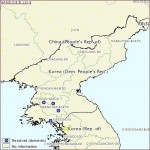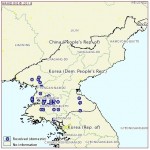According to the New York Times:
The United States Navy intercepted a North Korean ship it suspected of carrying missile technology to Myanmar two weeks ago and, after a standoff at sea and several days of diplomatic pressure from Washington and Asia nations, forced the vessel to return home, according to several senior American officials.
Washington made no announcement about the operation, which paralleled a similar, far more public confrontation with North Korea two years ago. But in response to questions about what appears to be a growing trade in missiles and missile parts between North Korea and Myanmar — two of the world’s most isolated governments — American officials have described the episode as an example of how they can use a combination of naval power and diplomatic pressure to enforce United Nations sanctions imposed after the North’s last nuclear test, in 2009.
It was a rare victory: a similar shipment of suspected missile parts made it to Myanmar last year before American officials could act. Despite the Obama administration’s efforts to squeeze North Korea with both economic and trade sanctions, there are continuing reports of sophisticated missile technology exchanges, some of it by air, between North Korea and Iran, among other nations.
North Korea, aware that shipments leaving the country are under increased scrutiny, has found a profitable trading partner in the authoritarian government in Myanmar.
The extent of that trade is unclear to American intelligence agencies. Two years ago, Secretary of State Hillary Rodham Clinton publicly expressed suspicions that Myanmar was attempting to purchase nuclear weapons technology, but it recently said it was too poor to use such technology. And the evidence has been scant at best. (In 2009, India inspected a North Korean ship that was believed to be carrying equipment for a nuclear reactor to Myanmar, but quickly discovered that its contents were legal.)
The most recent episode began after American officials tracked a North Korean cargo ship, the M/V Light, that was believed to have been involved in previous illegal shipments. Suspecting that it was carrying missile components, they dispatched a Navy vessel, the destroyer McCampbell, to track it.
“This case had an interesting wrinkle: the ship was North Korean, but it was flagged in Belize,” one American official said, meaning it was registered in that Central American nation, perhaps to throw off investigators.
But Belize is a member of the Proliferation Security Initiative, an effort begun by President George W. Bush’s administration to sign up countries around the world to interdict suspected unconventional weapons. It is an effort that, like the military and C.I.A. drone programs, Mr. Obama has adopted, and one of the rare areas where he has praised his predecessor.
According to American officials, the authorities in Belize gave permission to the United States to inspect the ship.
On May 26, somewhere south of Shanghai, the McCampbell caught up with the cargo ship and hailed it, asking to board the vessel under the authority given by Belize. Four times, the North Koreans refused.
As in the 2009 case, which involved the North Korean vessel the Kong Nam 1, the White House was unwilling to forcibly board the ship in international waters, fearing a possible firefight and, in the words of one official, a spark “that could ignite the Korean peninsula.” Moreover, the Americans did not have definitive proof of what was in the containers — and a mistake would have been embarrassing.
“There is always a chance that the North is setting us up for a raid that they know will find nothing,” one official said. “So we want to make sure we don’t fall into a trap.”
By happenstance, a group of senior officials from the Association of Southeast Asian Nations — including a representative from Myanmar — was in Washington while the slow-speed chase was occurring 8,000 miles away. On May 27, when the group visited the Old Executive Office Building opposite the White House, Gary Samore, the president’s top nuclear adviser, addressed the officials, urging Vietnam, Thailand, Indonesia and Malaysia to fully join the nonproliferation effort.
He then surprised the Asian officials by telling them he had a “sensitive subject” to raise, and described the American suspicions, providing the group with a picture of the ship on its way to Myanmar. He reminded them that under United Nations Security Council Resolution 1874, which was passed in response to the North Korean nuclear test in 2009, its vessels are to be inspected if “reasonable grounds” exist to suspect that weapons are being exported.
“The Burmese official in the room protested that we were making accusations,” said one American official familiar with the exchange. Myanmar, formerly known as Burma, has denied stockpiling missiles or buying parts from North Korea. It repeated those denials during recent visits to the country by a midlevel State Department official and by Senator John McCain.
American officials dismiss those denials, pointing to years of evidence of missile-related purchases during both the Bush and Obama administrations. But they concede they are mystified about Myanmar’s motives. The missiles that they believed were aboard the M/V Light have a range of about 350 miles, meaning they could hit parts of India, China, Thailand or Laos — all unlikely targets.
The message apparently got across. A few days later, long before approaching Myanmar, the cargo ship stopped dead in the water. Then it turned back to its home port, tracked by American surveillance planes and satellites, and suffering engine trouble along the way.
And according to the Wall Street Journal:
Under pressure from the U.S. and other countries, a North Korean vessel called the M/V Light turned around in the South China Sea two weeks ago and returned to the North last week, U.S. and South Korean officials said Monday.
Among the countries that agreed to apply pressure was Myanmar, a previous destination for North Korean weapons, a senior U.S. official said. Some reports said the North Korean ship was bound for Myanmar, but the U.S. official, Gary Samore, special assistant to President Barack Obama on weapons of mass destruction, said its final destination wasn’t clear.
“It was headed for the Straits of Malacca, which would have required it to pass between Malaysia and Singapore,” Mr. Samore said. “Since we had alerted the Singaporean and Malaysian authorities, there might have been concern [in Pyongyang] whether it could pass through the straits without action by either of those countries.”
The ship turned around, without the U.S. resorting to force, before reaching the straits.
North Korea’s state media haven’t reported on the latest journey of the M/V Light, keeping with a silence it maintained over previous interceptions of its weapons-ferrying ships and planes.
The incident is unlikely to change the fundamental standoff between North Korea and other nations over its nuclear-weapons program. The U.S., China and other countries have tried to lure North Korea back to the so-called six-party talks, in which Pyongyang has been encouraged to give up its nuclear pursuit in exchange for economic incentives and security guarantees.
Mr. Samore said the multilateral cooperation is a signal to North Korea that other nations remain committed to enforcing the trade limitations set forth by the U.N. Security Council several weeks after Pyongyang tested a nuclear weapon in 2009.
…
U.S. officials in late May began tracking the M/V Light, and a U.S. Navy destroyer intercepted it on May 26 and followed it down the Chinese coast for several days. Meanwhile, American diplomats won agreement from several southeast Asian nations to stop the ship if it attempted to make port.
U.S. officials also discussed the M/V Light with North Korean officials several times via the North’s U.N. delegation, a so-called back channel the two countries use because they don’t maintain official diplomatic relations.
“The North Koreans claimed the ship was going to Bangladesh with a cargo of industrial chemicals,” Mr. Samore said. “We have no way to verify whether any of that was true. And we had good reason to be suspicious with this ship, which in the past has been involved in the export of weapons to [Myanmar] and other locations in the Middle East.”
Read the full stories here:
U.S. Said to Turn Back North Korea Missile Shipment
New York Times
David Sanger
2011-6-12
North Korea Keeps Silent on Ship’s Turnaround
Wall Street Journal
Evan Ramstad
2011-6-14


